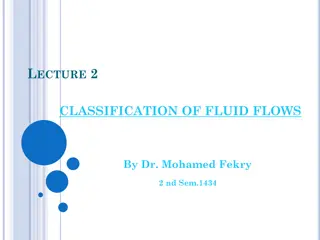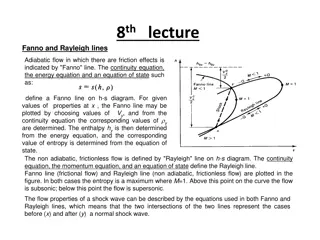Flow Measurement Using V-Notch and Weirs in Engineering
Flow measurement in engineering involves the use of V-notch and weirs, such as rectangular weirs and triangular weirs, to calculate discharge rates and velocity of liquids. A V-notch is a triangular obstruction used for flow measurement, while weirs are larger scale structures for measuring river or canal flow. Various types of weirs, such as sharp crest and broad crest weirs, serve different purposes in fluid dynamics. The flow velocity, coefficient of velocity, and discharge rate are calculated using Bernoulli's Theorem and other principles. Different configurations and applications of weirs and notches are discussed to understand their significance in hydraulic engineering.
Download Presentation

Please find below an Image/Link to download the presentation.
The content on the website is provided AS IS for your information and personal use only. It may not be sold, licensed, or shared on other websites without obtaining consent from the author.If you encounter any issues during the download, it is possible that the publisher has removed the file from their server.
You are allowed to download the files provided on this website for personal or commercial use, subject to the condition that they are used lawfully. All files are the property of their respective owners.
The content on the website is provided AS IS for your information and personal use only. It may not be sold, licensed, or shared on other websites without obtaining consent from the author.
E N D
Presentation Transcript
V Notch and Weirs for Flow measurement Dr. J. Badshah University Professor cum - Chief Scientist Dairy Engineering Department Sanjay Gandhi Institute of Dairy Science & Technology, Jagdeopath, Patna (Bihar Animal Sciences University, Patna)
Flow Over Notches and Weirs Notch: It is defined as an obstruction over which the flow of liquid occurs. The depth of flow above the base of the notch is related to the discharge, the notch forms a useful measuring device. It is triangular in shape with varying degree at crest and varying height of nappe. Weir: A weir is a notch on a large scale used for measuring the flow of a river, canal etc. It is a concrete or masonry structure of substantial breadth built across the river in the direction of flow. This allows the excess water to flow over its entire length to the downstream side. Thus a weir is similar to a small dam constructed across the river, with a difference that the excess water flows downstream only through a small portion called spillway and in case of weir, the excess water flows over its entire length. The sheet of water flowing through a notch or over a weir is known as nappe or vein. The bottom edge of the notch or the top of a weir over which water flows is known as sill or crest. The height above the bottom of the tank or channel is known as crest height.
Rectangular weirs The flow rate measurement is based on bernoulli s Theorem. Q= 2/3 Cdb (2g) =elevation head of the weir, b = width of weir and g =9.8 m/sq. s. 0.5(h)3/2 where, q= flow rate in cu.m./s, h Coeff. Of discharge (Cd) will be determined by analysis and caliberation tests. The sheet of water flowing through a notch or over a weir is known as nappe or vein. The bottom edge of the notch or the top of a weir over which water flows is known as sill or crest. The height above the bottom of the tank or channel is known as crest height.
Triangular or V- Notch weir Thin plate weir Suited for small flows fitted in side of tanks The flow rate q = 8/15 Cd(2g) ( )tan ( /2) (h)(5/2) = V-Notch Angle Free Flowing Weir : Liquid level on the downstream side is lower than the crest Drowned weir : Liquid level on downstream side submerges the crest Sharp crest weir: The crest is narrow Broad crest weir: The crest is broad Trapezoidal Weir: q =q1 + q2= 2/3 Cdb (2g) 0.5(h)3/2+ 8/15 Cd(2g) ( )tan ( /2) (h)(5/2)
Numericals 1. Calculate the flow velocity of water at the opening of an orifice if the orifice is located 4 m below the water surface in a tank. V = 2gh = 2 x 9.81 x 4 = 8.85 m/s 2. Calculate the coefficient of velocity Cv if the actual velocity of jet is 5.1 m/s. Orifice is located 2m below the water surface in a tank. Solution: Cv= Actual velocity/Theoretical velocity = 5.1 / 2gh = 5.1 / 2 x 9.81 x 2 = 0.814 3. Determine discharge through a internal mouthpiece (running free) if there are a y mouth piece is 0.09 m2 . The distance between the centre of mouthpiece and free water surface is 2.5 m. 4. 4. Determine discharge through a internal mouthpiece (running free) if the are a of mouthpiece is 0.15 m2 . The distance between the centre of mouthpiece and free water surface is 3.0 m.
Numericals on weir 5. Determine flow rate through a rectangular hutch if L = 0.20 m and H = 0.15 m. Take value of cd = 0.645 6. Determine flow rate through a triangular hutch if H = 0.20 m and . Take value of cd = 0.85.






















